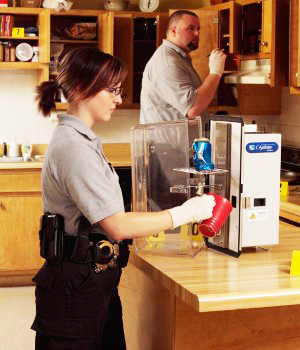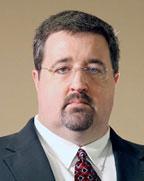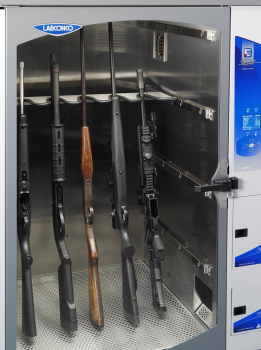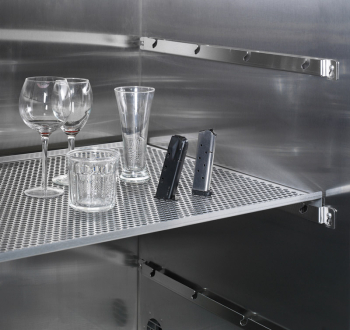Cyanoacrylate Fuming Tutorial: Understanding the Variables
 Cyanoacrylate fuming (aka CA fuming or superglue fuming) is widely recognized as a powerful and useful process for the visualization of latent fingerprints on many types of surfaces. Almost nothing in the forensic sciences, however, is less standardized. What is considered holy writ in one laboratory may be a prohibited practice in another. Equipment can range from rudimentary containers to highly sophisticated laboratory cabinets. Results are often varied and erratic and there seems to be no correlation to expense.
Cyanoacrylate fuming (aka CA fuming or superglue fuming) is widely recognized as a powerful and useful process for the visualization of latent fingerprints on many types of surfaces. Almost nothing in the forensic sciences, however, is less standardized. What is considered holy writ in one laboratory may be a prohibited practice in another. Equipment can range from rudimentary containers to highly sophisticated laboratory cabinets. Results are often varied and erratic and there seems to be no correlation to expense.
To achieve optimum results in latent print development using the CA process, it is first necessary to identify and understand the variables involved. The evolution of the different cyanoacrylates, now manufactured specifically for latent print development, as well as the introductions of a wide variety of fuming chambers, have induced a false belief that one only needs to push the “Start” button in order to achieve the best possible results.
It is imperative that users understand the process of polymerization and know that the variables involved must be understood and addressed. Unfortunately, many technicians adopt the same attitudes observed in many photographers - they put unwarranted faith in the “automatic” settings for both camera and CA chamber with predictably mediocre results.
In CA fuming and polymerization, the user must understand the applications of temperature and humidity, the viscosity of the CA employed, the respective substrates being treated and that the amount of fuming time depends a great deal upon these variables. Consistency and repeatability of results will be the natural result of this understanding. This applies to the most rudimentary field techniques for CA development and to the use of expensive laboratory CA cabinets. I attempt to address in this article the variables over which the user has some control and to recognize the variables over which the user has no control.
What are the Variables?
The user can exert some level of control over the type and amount of glue employed, heat, humidity, chamber size, the movement of air within the chamber and, of primary importance, the fuming time.
The variables over which the user has no control are the substrates and compositions of the submitted items, the age of the items, the quality of the latent prints already deposited and any contaminants on the surfaces of the items.
The CA fuming process is simple. CA (super glue) is volatilized by heat in a contained area in which the humidity is controlled and the items to be processed have been placed. The CA fumes bond to the surfaces of the items and latent print visualization is, hopefully, achieved. Unless, however, the aforementioned variables are understood and addressed, results can be frustrating and unpredictable.
Glue Variables
Understand first that CA glues are different. They range in viscosity from gels (high viscosity) to nearly water-like (low viscosity). Low viscosity glues are quicker to vaporize and can thus reduce processing time, but some will thicken with age and thus necessitate a longer exposure time. The method by which the user stores the glue can also introduce an unwanted variable. Glue stored in a refrigerator should be left in the refrigerator until just prior to use.
The amount of glue used depends upon the size of the chamber.
Humidity Variables
Controlled humidity is a necessity. Depending upon your location, as published in previous studies, humidity is optimal at 70 to 80 percent. The mechanisms employed to induce this humidity range from the insufficient to the ideal to the absurd. A cup of very warm water, while possibly acceptable in a five- gallon aquarium, is woefully inadequate when placed in a 30 cubic foot cabinet. Some very expensive commercial CA cabinets have been observed to have a department store room humidifier attached to the cabinet by means of a hose through which steam, and sizeable water droplets, are sprayed into the cabinet. Water literally runs down the side of the cabinet, condensation forms on the evidence and the user may be none the wiser.
Hygrometers, instruments used to measure relative humidity, are inexpensive and readily available. The employment of a hygrometer and a control mechanism that allows for a calibrated, accurate real-time reading for the induction of the humidity are necessary.
Temperature Variables
Heat is probably the most misunderstood, and widely varied, of the variables under discussion. Heat can be adjusted to suit the user’s preference, the type and size of the cabinet employed and the type of glue in use. It must, however, be subject to control by the user. Higher heat, within reason, will result in shorter fuming times and lower heat, conversely will result in longer fuming times. On some items, the latter is more desirable in order to avoid over-fuming. In any event, control must rest with the user.
I have personally observed one brand of commercial cabinets which contain heat sources not designed for the purpose, cannot be adjusted by the user and which vary from cabinet to cabinet by as much as 40 degrees Celsius!
Managing the Variables
The CA is typically placed in a foil boat atop the heat source and allowed to vaporize. Lower viscosity glues spread quickly across the surface of the foil boat and are vaporized more easily than thicker glues that tend to mound. Experimentation with an individual cabinet will enable the user to quickly determine the ideal amount of glue for a particular cabinet.
It is necessary to weigh the glue, in the boat before and after the fuming process. When the boat is found to retain about 10 percent or less of its original weight, and test prints are acceptably visualized, the ideal time to glue amount ratio has been achieved.
The heat source should match, or be larger than, the size of the glue containment boat. Ideally, the foil boat will be subjected to uniform heat across the entire boat, allowing an even vaporization of the CA. The heat source must, of course, be level to avoid mounding of the glue, and the foil boat must be of sufficient size to allow the glue to spread evenly across the interior surface of the boat.
Under-fuming can be a problem when users stop the fuming cycle before the latent prints have fully developed. This can be complicated by the mixing of certain types of surfaces that are prone to over-development. Other factors can be the addition or reduction in the amount of cyanoacrylate to the boat that may be necessary for proper fuming results. The user must be cognizant, however, that additional time is now required, as well. It should be noted that latent prints under-fumed with the newer dye stain infused CA formulas will not fluoresce as intended.
Over-Fuming
Over-fuming is a little more complicated. Some surfaces like highly polished firearms, well-handled plastic bags and bottles are much more susceptible to over-fuming than other types of evidence and must be watched carefully throughout the process. It is frequently necessary to remove such items long before it is necessary to remove other types of evidence. Slight over-fuming with the dye infused CAs does not appear to present much of a problem.
Over-fuming may also result in leaving evidence in cabinets that have a limited timed purge cycle. This can occur when the user is not around to immediately remove the foil boat and remaining CA at the end of the fuming cycle. The user may believe since the purging cycle has started that the fuming cycle has stopped. But if the cabinet has an automated limited time purge cycle, the CA still atop a warm heat source will continue to fume throughout and well past when that purge has completed its cycle.
Bringing it All Together
If the CA chamber is used for successive batches of evidence immediately upon removing items from a prior cycle, the heat source will still be warm and the time of exposure may have to be changed to prevent over-fuming in the subsequent cycles.
Air movement within the chamber is the most overlooked of all the listed variables. If the CA vapor is not distributed evenly within the chamber, it is possible to get both under-developed prints and over-developed prints in the same processing cycle, even on the same piece of evidence. Relying on gravity or an insufficiently powered fan to distribute the CA vapor uniformly throughout the chamber will give uneven and erratic results. Correct air circulation is vital to achieving uniformity and repeatability in results.
A fresh, observable test print must be used for each cycle whether in testing or during the processing of real evidence. Results should be noted for each cycle in order to identify any problems as quickly as possible.
Summary
In summary, removal or control of the listed variables will go a long way toward ensuring the uniformity of results. Using the same type of CA, the same brand and type of foil boat, the same heat, the same humidity and, with the noted exceptions, the same time exposures will enhance productivity in case work and lessen dependence on guesswork.
Laboratory CA chambers are expensive and great care should be taken in the selection of a commercially produced cabinet. Close attention to the variables listed here should give the buyer some confidence in the eventual choice of cabinet. Ask how long an effective purge takes. Ask the manufacturer to demonstrate, to the user’s satisfaction, the effectiveness of the air movement within the cabinet. Ask if the heat source is specifically designed for this purpose. Ask to be shown the method by which the user controls the heat and levels the heat source. Ask about the humidity induction, calibration and ask to have the controls demonstrated. Above all, ask how and why a particular cabinet differs from those of other manufacturers.
The final step is to determine the price per square foot of processing area you will get for your money. This will allow you to compare various enclosures on an equal footing. How much processing volume are you obtaining for your dollar?
After getting answers to the questions above, you’ll be well informed to select the right CA fuming chamber for your needs, now and in the future.

| chevron_left | Biosafety Cabinets 101 | Articles | Improving Energy Efficiency in the Lab | chevron_right |



.png)




